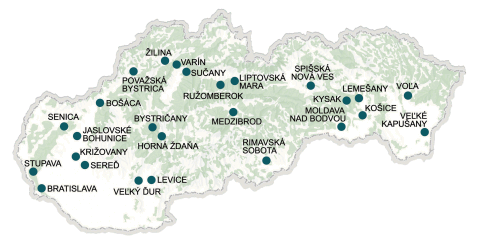all newsNews
XMtrade®/ISOT to support 15-minute trading on the day-ahead market
8/28/2025
The planned introduction of a 15-minute trading interval on the single-day-ahead electricity market ... more
Participate in the ENERGOFÓRUM® 2025 event online
8/21/2025
Under the organisational leadership of our company, energy experts will meet for the nineteenth time... more
We discussed the prospects of modern energy
8/14/2025
When it comes to energy transformation, sustainability and digitalization, our colleague, Ing. Peter... more
 |
Description |
XMatik®.NET is a common tool for building of technical information systems in the field of property management and maintenance. XMatik®.NET possesses unique possibilities of graphical modeling and analysis of hierarchical and network relations between devices in technology together with management of preventive maintenance, operation and diagnostics, defects monitoring and evaluation. In energetics, petrochemicals, road management, distribution management and others it provides branch solutions, which directly support customer business activities.
- XMatik®.NET as a source of information
- XMatik®.NET as service provider
- System characteristics of the XMatik®.NET
- Advantage of implementation of Microsoft.NET technology into XMatik® system
- Operating conditions
- Implementation
XMatik®.NET as a source of information
XMatik®.NET serves as source of information for anyone who wants to effectively managed his property, device and technological units:
- what do we have and where it is (sorts and numbers of devices in hierarchical representation)
- what are the parameters (types, producer/manufacturer, year of manufacture/construction,
- device adjustment, technical and technological parameters)
- what was done with it and in what stste it is (life cycle)
- what we can do with it (technological procedure, Procedure of preventive activities)
- what I have to do with it (maintenance or calibration plans)
- what are the legal and spatial relations between objects (integrated land registry of the Slovak Republic)
XMatik®.NET as service provider
XMatik®.NET provides:
- Complex overview about company property and technical parameters of device
- Easy and quick identification of device and information gaining according to various criteria - locality, functional place, type, manufacturer/producer, age, technical parameters, ...
- Graphic identification of objects and devices in schemes representing hierarchical and network relations in technological units
- Finding and visualization of network relations, answers to
following question:
- Where does the links go to (lines, flows, roads, …)?
- What are the possible interconnections between objects X and Y? Which of them is optimally according to defined criteria?
- Is given link free or busy (connect or disconnect)?
- Which objects cross the way from X to Y?
- Summary of device life cycle events - acquisition, categorisation, maintenance, diagnostics, defects, errors, reparations, exchange, evaluation, eliminating
- Automatic creation and print of frequently repeated output sets
and drawings, e.g.:
- Operative schemes
- Maintenance, measuring and diagnostic protocols
- Details for reparation and maintenance invoicing
- Technological procedures for maintenance execution
- Failure statistic
- Global property overview
- Regular reports e.g. Operating report, Failure report, Procedure of preventive activities ...
- Possibility of updating of information and operative documents by users according to specific organizational structure and responsibility
- Instantaneous information and operative documents availability for wide range of users in the network according to assigned authorization
- Displaying of hierarchy according to father-son relation (special topological relations)
- Rules management - what kind of activities and their interval can be executed on device - "Procedure of preventive activities"
- Possibility to define supplementary conditions according to object parameters (e.g. generation of activities according to active protection functions) and operation conditions (contamination factor, current, voltage)
- Definition remind, which ensure e.g. sending message warns to need for execution of activities at given time
System characteristics of the XMatik®.NET
- Detaching and independence of application layers from program tools - at the level of basic tools (database and graphic subsystem, office programs) XMatik®.NET uses generally advanced tools by world's top software manufacturers/producers (Bentley Systems, Incorporated, Oracle, Microsoft), at the top level there are self application programs created according to customers need in practice. Clear detaching these two layers allows alternative using or replacing of basic tools by other products or upgrade products.
- Integrated database - all objects information (including relations accessible to users through graphic schemes) are stored in central database. Using of standard RDBMS of Oracle Corporation ensures users data safety, brings strong tools for protecting, recording and system integration with other user applications into integrated information system.
- Support of modern network and intranet technologies - XMatik®.NET provides complex tools for safety sharing of big database units within the wide and remote network configurations with possibility to use intranet technologies for workstations and thereby connection of large number of users.
- Data protection managed and controlled access to the functions and data - according to real needs and competencies of single users. There are individually accessible special information and system functions
- Installation configuration on the workstations allows reduce
costs of their implementation - equipment of workstation with
program tools depends on system functionality requirements:
- Total modification workplace - all graphical, database and administrative functions
- Analytically-modeling workplace - graphic functions without possibility of update or creation of new schemes
- Intranet browser workplace - browser and output functions, graphic display only through the internet browser (e.g. Internet Explorer)
- Data transportability - XMatik®.NET supports export of graphical and non-graphical data into the other systems and possibility to import and maintenance different data types from external sources.
- Generality and openness - before implementation of specific application of XMatik®.NET is necessary to suggest a data structures and fulfill database by objects information. Openness of the system allows continuously extend the data structures and update application functions according to customers requirements.
Advantage of implementation of Microsoft.NET technology into XMatik® system
XMatik®.NET brings cardinal improve due to implementation of Microsoft.NET technology in the following areas:
- adaptability
- productivity
- integrating
- system administration
Advance users interface and system control by complex conservation is certainty.
XMatik®.NET allows solution configuration for end user according to his individual needs. The configuration doesn't need producer program adjustment. Solution administrator has possibilities to:
- creation and modification of forms for registered records
- modification of program behavior by defined events
- insert users modules with new functions into system
These modifications are executed in Microsoft Visual Basic .NET standard environment.
User receive new added value to property administration and maintenance in XMatik®.NET. Solution is configured into specific environment, so that it is completely adjusted to specific task and specific process. It allows high users productivity especially in the cases of complicated and complex environment.
Obvious is possibility to create interconnection to other user system so that these systems creates one logical unit. These interconnections are always solved in individual way and XMatik®.NET provides support for their implementation - web services or individual modules. It is most frequently interconnection to ERP system (XMatik®.NET has interconnection module to SAP/R3), but important interconnection are also to the control systems, digital register, intranet or system of partner companies - purchaser or customer.
Within the product XMatik®.NET is possible to implement system modifications without significant expenses concerning to standard and accessibile environment for system configuration - Microsoft Visual Basic .NET.
Recommended operating conditions
AS Server:
- OS Windows Server, IIS, Microsoft .NET, Oracle client, Microsoft Office 2010
- CPU 8x core, RAM 4GB, HDD 10 GB
DB Server:
- Oracle server 11g
- CPU 8x, RAM 4 GB, HDD 20 GB (without user data)
Client:
- OS Windows 7, Microsoft .NET, Oracle client, Microsoft Office 2010
- MicroStation V8, Bentley PowerMap V8, Bentley Redline V8
- CPU 2x core, RAM 1 GB, HDD min. 1 GB
Implementation

Choose what you need from our products
- Services
- Consulting and analyses in power industry
- Processing of technical data
- Processing of graphic data
- Processing of CAD data
- Sale and installation of software
- Sale and installation of hardware
- Accredited certification services for electronic signature
- Double-entry bookkeeping, maintenance of personnel and payroll agenda
- Solutions
- Virtual reality
- Energy trading
- Electricity dispatching
- Facility management and maintenance
- Devices and equipment lifecycle management
- Technological networks management
- Technical documentation maintenance
- Road network management
- Energetic networks design
- Maps, atlases and other map works
- References
- Technical information systems
- Trading information systems for power industry
- Consulting and analyses in power industry
- Graphic applications
- Cartography
- CAD
- Professional portals
- sféra workshops
- Legislative obligations
- ENERGOKLUB®
- ENERGOFÓRUM®

